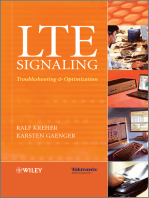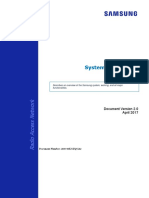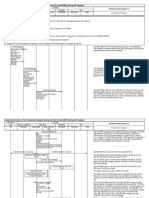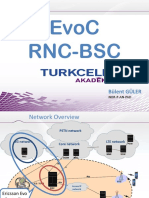4 Vo5G Solution Introduction ISSUE 1.00
4 Vo5G Solution Introduction ISSUE 1.00
Uploaded by
myososCopyright:
Available Formats
4 Vo5G Solution Introduction ISSUE 1.00
4 Vo5G Solution Introduction ISSUE 1.00
Uploaded by
myososCopyright
Available Formats
Share this document
Did you find this document useful?
Is this content inappropriate?
Copyright:
Available Formats
4 Vo5G Solution Introduction ISSUE 1.00
4 Vo5G Solution Introduction ISSUE 1.00
Uploaded by
myososCopyright:
Available Formats
Vo5G Solution Introduction
www.huawei.com
Copyright © Huawei Technologies Co., Ltd. All rights reserved.
References
3GPP Technical specification (TS) references for this course:
Copyright © Huawei Technologies Co., Ltd. All rights reserved. Page2
Objectives
Upon completion of this course, you will be able to:
Describe Vo5G Voice/Video Communication Solution Consideration
Describe EPC-based 5G Voice/Video Communication Solution
Describe 5GC-based 5G Voice/Video Communication Solution
Copyright © Huawei Technologies Co., Ltd. All rights reserved. Page3
Contents
1. Vo5G Voice/Video Communication Solution Consideration
2. EPC-based 5G Voice/Video Communication Solution
3. 5GC-based 5G Voice/Video Communication Solution
4. Voice/Video Communication Solution Evolution
Copyright © Huawei Technologies Co., Ltd. All rights reserved. Page4
What Is Vo5G?
Vo5G Solution
Copyright © Huawei Technologies Co., Ltd. All rights reserved. Page5
Vo5G Solution Consideration
Bandwidth Cost Reduction and Experience Improvement in the 5G Era
Drive Video Communication to Become a Basic Service.
4G 5G
• The single-bit bandwidth cost is high, resulting • The uplink bandwidth and cell capacity of a 5G network are 10 to
Utilization
in high service fees, which are charged at a 20 times higher than those of a 4G network, reducing the single-
cost
minute+traffic, traffic, or minute level. bit bandwidth cost.
• UEs supporting video calls gradually become popular.
• The popularity rate of UEs supporting video
• Carriers gradually realize inter-network video interconnection.
calls is low.
Reachability • The video media conversion technology is deployed to support
• Inter-network video communication is not
video communication between UEs, TVs, cameras, and vehicle-
supported.
mounted devices.
• There is no network adaptation mechanism for
terminals from different manufacturers. • H.265 is used as the default codec to lower network coverage
Consequently, video freezing occurs or an requirements.
Service
image with artifacts is displayed on terminals in • The resolution, frame rate, and bit rate are dynamically adjusted
experience
weak coverage scenarios. based on the collaboration of UEs and the network.
• Only point-to-point video communication is • Multi-party video communication is supported.
supported.
Copyright © Huawei Technologies Co., Ltd. All rights reserved. Page6
Vo5G Solution Consideration (Cont.)
Voice services sensitive to packet losses
VoNR voice packets are transmitted in accordance with the UDP protocol,
which is similar to that for VoLTE voice packets. If VoNR voice packets are
lost, they will not be retransmitted.
Consequently, the called party cannot accurately restore the voice, causing
one-way audio, voice skipping, or intermittent voice.
Number of consecutively lost packets > 6
Voice skipping or
intermittent voice N-1 N N+10 N+11
Maximum packet transmission interval ≥ 140 ms *An RTP voice packet is
sent every 20 ms.
Instantaneous jitter
N-1 N N+1 N+2
Copyright © Huawei Technologies Co., Ltd. All rights reserved. Page7
Vo5G Solution Consideration (Cont.)
Source Target
UE S-GW/UPF
Analysis of the 4G/5G gNodeB eNodeB
User plane
handover interruption duration Reconfigure an RRC connection, indicating that a handover starts.
User plane
Change the RF unit and
baseband processing unit, and 40 ms
update security configurations. Cache downlink data.
Search for the target cell. 0 to 40 ms
Obtain the target PRACH. 15 ms
Reserve the protocol-defined margin. 15 ms
Send PRACH preamble. 1 ms
Allocate uplink resources. 4 ms
Reconfigure the RRC connection, indicating that the handover is complete. 6 ms
User plane
Total uplink voice interruption duration: 81 ms to 121 ms
Copyright © Huawei Technologies Co., Ltd. All rights reserved. Page8
Vo5G Solution Consideration (Cont.)
The EVS industry is expected to further improve voice quality.
Copyright © Huawei Technologies Co., Ltd. All rights reserved. Page9
Vo5G Solution Consideration (Cont.)
EVS provides significant coverage gains, effectively alleviating the
coverage pressure of the 5G high spectrum.
Copyright © Huawei Technologies Co., Ltd. All rights reserved. Page10
Contents
1. Vo5G Voice/Video Communication Solution Consideration
2. EPC-based 5G Voice/Video Communication Solution
3. 5GC-based 5G Voice/Video Communication Solution
4. Voice/Video Communication Solution Evolution
Copyright © Huawei Technologies Co., Ltd. All rights reserved. Page11
Application Scenarios of 5G Networks
Fixed broadband access and Extended-bandwidth coverage in hotspots
Ultra-high personnel density
There is more than one
person in each square meter.
Copyright © Huawei Technologies Co., Ltd. All rights reserved. Page12
NSA Networking Introduction
Non standalone (NSA)
EPC
Legacy LTE radio access Control plane
User plane
networks and core networks
S1 S1
are used as anchor points
for mobility management X2
and coverage, and 5G LTE 5G NR
Master node Secondary node
networks are incorporated
into such legacy networking
*Use option 3x as an example.
for network access.
Copyright © Huawei Technologies Co., Ltd. All rights reserved. Page13
NSA Networking Introduction (Cont.)
EPS EPS
bearer 1 bearer 2
NSA user plane
EPC S-GW
If 5G network signals are S1-U
3 3 SCG split
MCG 2 Data packet Data packet 2
poor, a 5G gNodeB can bearer 1 1
bearer
Traffic
instruct an LTE eNodeB to LTE eNodeB 5G NR distribution
3
send or receive data PDCP NR PDCP
packets on bearer 2 or can RLC RLC X2 NR RLC
initiate a handover to hand MAC MAC NR MAC
over data packets on bearer
Master 3 Secondary
2 to an LTE eNodeB. node node
*MCG (master cell group)
*SCG (slave cell group)
Copyright © Huawei Technologies Co., Ltd. All rights reserved. Page14
Reconstruction Points for NSA Option 3/3a/3x
MME function changes
• Option 3/3a/3x networking HSS function changes PCRF function changes
• Extended QoS: AMBR, GBR, and • Support for the value range of the • 4G/5G subscriber identification for
UTRAN maximum bandwidth for the delivering different charging control
MBR
• E-RAB modification for split AMBR QoS policies
bearer
SGSN • DCN Selection (DÉCOR) • Support for the maximum
• 5G NR access control HSS • 4G/5G subscriber subscription bandwidth range for the AMBR
GERAN • Dual connectivity authorization QoS
• 5G NR traffic-based charging
• 4G/5G gateway selection
S3
• 5G independent performance S1-MME S6a
statistics and alarms MME
PCRF
• (Optional) DÉCOR
S12 Rx
• (Optional) 5G subscription control S11
S4 Gx
LTE-Uu S10 Operator's IP
Serving S5 PDN SGi Services
UE E-UTRAN Gateway Gateway (e.g. IMS, PSS etc.)
S1-U
Gateway function changes
NR S1-U • Option 3/3a/3x networking
• Extended-bandwidth QoS
• Extended bandwidth for a single user
• Cloud-based CUPS deployment (optional but
recommended)
• 4G/5G gateway selection/distribution
• 5G NR traffic-based charging
• 5G independent performance statistics and alarms
Copyright © Huawei Technologies Co., Ltd. All rights reserved. Page15
NSA Option 3/3a/3x Voice Solutions
VoLTE/CSFB solution is used as the only voice solution.
Voice service solution principles: IMS APN traffic is only distributed to LTE
eNodeBs. Calls are processed by LTE eNodeBs in compliance with the
VoLTE or CSFB solution.
SMS solution principles: SMSs on VoLTE UEs are processed by an IMS
network, and SMSs on data cards are processed over the SGs interface.
NR
EPC Data
VoLTE LTE Voice
Copyright © Huawei Technologies Co., Ltd. All rights reserved. Page16
NSA Option 3a Voice Solutions
A gNodeB is preferentially selected to carry VoNR services.
Voice service solution principles: IMS APN traffic is preferentially distributed to
gNodeBs. If subscribers initiate calls in NR coverage areas, the calls are
processed by gNodeBs in compliance with the VoNR solution. The VoLTE
solution is used if there is no NR coverage.
SMS solution principles: SMSs on VoNR or VoLTE UEs are processed by an
IMS network, and SMSs on data cards are processed over the SGs interface.
VoNR
NR
EPC Data
LTE Voice
Copyright © Huawei Technologies Co., Ltd. All rights reserved. Page17
VoNR Introduction
NSA Option 3a Allows NR to Bear Voice Services
VoLTE
EPS bearer 1
bearer
EPC S-GW
MCG bearer 3 S1-U 3 SCG bearer
2 Data packet Data packet 2
1 1
LTE eNodeB 5G NR
PDCP NR PDCP
RLC X2 NR RLC
MAC NR MAC
Master node Secondary node
Copyright © Huawei Technologies Co., Ltd. All rights reserved. Page18
Reconstruction Points for NSA Option 3a to
Use VoNR (Compared with VoLTE)
IMS
Signaling HSS
Sh TAS/
SMSC
IP-SM-GW
Media
Cx
Rx
MME PCRF P-CSCF S-CSCF
UE eNB/NR S/PGW AGW, MRFP… B party
Gm
UE function changes eNodeB/NR function changes HSS/IMS/PCRF/DRA function change
• Support for VoNR • VoLTE traffic is distributed to a gNodeB. • NA
• Voice services are enabled on a gNodeB.
Copyright © Huawei Technologies Co., Ltd. All rights reserved. Page19
Contents
1. Vo5G Voice/Video Communication Solution Consideration
2. EPC-based 5G Voice/Video Communication Solution
3. 5GC-based 5G Voice/Video Communication Solution
4. Voice/Video Communication Solution Evolution
Copyright © Huawei Technologies Co., Ltd. All rights reserved. Page20
4G/5G Network Interoperability Architecture
Converged
Convergence of key NEs NEs
HSS +
UDM
ensures service continuity N10 PCF +
S6a PCRF N8
of 5G subscribers on 4G N7
SMF + N15
PGW-C
and 5G networks. S5-C
N4
UPF +
N11
PGW-U
During the handovers S11
SGW
S5-U
between 4G and 5G MME
N26
AMF
S1-U U N3 N2
networks, UE IP addresses S1-MME
N1
E-UTRAN NG-RAN
remain unchanged, and
*From 3GPP TS 23.501
services are continuous. UE UE
Copyright © Huawei Technologies Co., Ltd. All rights reserved. Page21
5GC Network Construction Solutions
Solution 1: EPC is upgraded to support 5GC
Major challenges: Can PS hardware capabilities on the live network meet 5G
requirements? Large investments are required because all NEs are upgraded.
HSS/ PCRF/
UDM PCF
MME/
4G eNB
AMF
gNB SGW/ PGW/
5G UPF UPF
Copyright © Huawei Technologies Co., Ltd. All rights reserved. Page22
5GC Network Construction Solutions (Cont.)
Solution 2: A new 5GC is deployed on the EPC
The EPC on the live network processes services of 4G UEs and roaming
services of 5G UEs on 4G networks.
The new 5GC processes only services of 5G UEs.
HSS PCRF
5G UEs access eNB MME
4G
a 4G network.
SGW PGW
Bidirectional
handover UPF/PGW-U
gNB AMF SMF/PGW-C
5G
UDM/HSS PCF/PCRF
5G UEs access a 5G network.
Copyright © Huawei Technologies Co., Ltd. All rights reserved. Page23
Solutions to Ensure PS Service Continuity
Solution 1: Service continuity based on N26 interface standard 4G/5G
handover for Single Radio UE
4G eNodeB S-GW
S3
MME
UPF/PGW-U
Handover N26 Transfer bearer contexts.
AMF SMF/PGW-C
Control plane
gNodeB
5G N3
User plane
*Use a 5G-to-4G handover as an example.
Before a handover Handover execution After a handover
eNodeB eNodeB eNodeB
EPC EPC EPC
Buffer
5GC 5GC 5GC
gNodeB gNodeB gNodeB
Copyright © Huawei Technologies Co., Ltd. All rights reserved. Page24
Solutions to Ensure PS Service Continuity (Cont.)
Solution 2: Service continuity based on Attach procedure without N26
interface for Single Radio UE
S1-U
4G eNodeB S-GW
S3
MME
Transfer the P-GW ID UPF/PGW-U
Reselection
UDM/HSS
AMF SMF/PGW-C Control plane
User plane
5G gNodeB
N3
*Use a 5G-to-4G handover as an example.
Services performed on a 5G UEs decide to hand over to a 4G network attach After 4G service
network 4G network. If bearer setup is process migration
Attach messages Obtain the P- complete, a 5G
eNodeB indicate the bearer ID. eNodeB network is eNodeB eNodeB
GW ID.
EPC EPC disconnected. EPC EPC
HSS
Set up a
UDM bearer.
5GC 5GC 5GC 5GC
gNodeB gNodeB gNodeB gNodeB
Copyright © Huawei Technologies Co., Ltd. All rights reserved. Page25
Solutions to Ensure PS Service Continuity (Cont.)
Solution 3: Service continuity based on dual registration without N26
S1-U
interface 4G eNodeB S-GW
S3
MME
Transfer the P-GW ID UPF/PGW-U
PDN Session Migration
UDM/HSS
AMF SMF/PGW-C Control plane
User plane
5G gNodeB
N3
*Use a 5G-to-4G handover as an example.
Dual registration UEs decide to hand over to a 4G network PDN After 4G service
on 4G/5G network 4G network. establishment process migration
PDN connection
establishment indicate Obtain the If bearer setup is
eNodeB eNodeB P-GW ID. complete, a 5G network eNodeB eNodeB
the bearer ID.
EPC EPC is disconnected. EPC EPC
HSS Set up a
UDM bearer.
5GC 5GC 5GC 5GC
gNodeB gNodeB gNodeB gNodeB
Copyright © Huawei Technologies Co., Ltd. All rights reserved. Page26
Session Binding Requirement
*BSF (Binding Support Functionality)
When a UE accesses a 5G SMF BSF PCF 1 PCF 2
network and there are multiple
Npcf_SMPolicyControl_Get (IMSI, IP)
PCFs, the BSF is required to A session is created,
The PCF records
with the relationship
information about
perform session binding. between IP addresses
and PCF IDs bound.
SMF serving a
specific UE.
P-CSCF
Nbsf_Management_Discovery (IP)
PCF ID Query the relationship
between UE IP addresses
and PCF IDs to obtain the Forward the
target PCF ID. dedicated bearer
AAR setup request to
the SMF serving a
UE.
Copyright © Huawei Technologies Co., Ltd. All rights reserved. Page27
DRA and BSF Interoperability
DRA and BSF interoperability is required if multiple PCFs and PCRFs
are configured when 4G and 5G networks co-exist.
Analysis of P-CSCF addressing DRA/BSF:
DRA P-CSCF DRA PCRF1
P-CSCF
1. The DRA is 2a: If the DRA contains
always selected. 2b: If the DRA does not the session binding
BSF contain any session information related to
binding information 4G network access, it
related to 4G network directly routes such
The DRA and BSF are selected based on access, it queries the information to the PCRF.
the PANI information in the SIP header field: BSF to obtain the PCF ID.
PANI = E-UTRAN: The DRA is selected.
PANI = NR: The BSF is selected. BSF
Copyright © Huawei Technologies Co., Ltd. All rights reserved. Page28
DRA and BSF Interoperability (Cont.)
DRA and BSF Deployment Solution
Solution 1: The DRA and BSF P-CSCF DRA PCRF 1
are deployed separately.
BSF
[Deployment reconstruction cost]
The legacy DRA needs to be upgraded to support the
connection to the BSF in HTTP mode.
Solution 2: The DRA and BSF are co-deployed.
The BSF needs to be deployed.
[Addressing path] P-CSCF DRA/BSF PCRF 1
P-CSCF->DRA->BSF->DRA->PCRF: A large number of
NEs are involved, resulting in a long delay. [Deployment reconstruction cost]
The 4G/5G convergence signaling routing node can be
implemented by an upgraded DRA on the live network
(recommended) or by a newly deployed node.
[Addressing path]
P-CSCF->DRA/BSF->PCRF: The number of involved NEs
decreases, resulting in a short delay.
Copyright © Huawei Technologies Co., Ltd. All rights reserved. Page29
Vo5G Remains Based on IMS Network
Vo5G provides voice services based on IMS network.
Vo5G provides voice services based on 5G network access and the original
IMS architecture.
3GPP R15 does not specify any changes in the IMS network architecture.
Vo5G support emergency calls for 5G voice services.
Vo5G does not provide direct interoperability between 5G voice services
and 2G/3G voice services.
Vo5G provides IMS-based voice services only on LTE or 5G networks.
Copyright © Huawei Technologies Co., Ltd. All rights reserved. Page30
Vo5G Deployment Solutions
Transition solution Target solution
LTE networks are always used to provide voice Both 5G and LTE networks
services, and 5G networks provide only data services. provide voice services.
EPS/RAT fallback Dual registration In 5G coverage areas, 5G and IMS
networks jointly provide voice
If voice services trigger PS If 5G and 4G networks provide overlapping services. If a UE moves out of the 5G
handovers in 5G coverage coverage and UEs are configured with two coverage area during a call, PS
areas, both voice and data RF modules, voice services are processed handovers are performed to ensure
services will fall back to LTE only on the LTE network, and data services service continuity on 5G and LTE
networks. are processed on the 5G network. networks.
Copyright © Huawei Technologies Co., Ltd. All rights reserved. Page31
5G Deployment is Beneficial to VoLTE
Vo5G deployment is simplified to avoid the complexity of four-network
collaboration and reduce investments.
As specified in 3GPP R15, 5G UEs cannot perform CSFB to a 2G/3G
network, increasing the possibility that LTE networks function as the
foundation network.
Contiguous voice coverage requires VoLTE to be used as the foundation
network.
5G-to-3G SRVCC will not be widely deployed because it interrupts data
services and worsens user experience.
Copyright © Huawei Technologies Co., Ltd. All rights reserved. Page32
VoNR/VoeLTE Process
VoNR/VoeLTE procedure is the same as the VoLTE procedure.
UE NG RAN AMF SMF/ UPF PCF IMS
1. MO or MT IMS voice session in 5GS; QoS flow for voice establishment initiated
2. NW initiated PDU session modification to setup QoS flow for IMS voice
3. User plane
Reconfiguration
4. Accept PDU session modification for IMS voice
5. IMS Voice session establishment continued
Copyright © Huawei Technologies Co., Ltd. All rights reserved. Page33
VoNR/VoeLTE E2E Call Delay Analysis
E2E delay (T1+T2+...+T12) = 1s to 2s
UE A NR 5GC SBC S-CSCF TAS I-CSCF S-CSCF TAS HSS SBC 5GC NR UE B
T1 Call Initiation
Dedicated Bearer
T2 Request
Dedicated Bearer Dedicated Bearer
T3 Notification
Creation
T4 Call Initiation
T5 Retrieval S-CSCF of B Party
T6 Call Initiation
T7 T-ADS
T8 Call Initiation
T9 Call Ringing
Dedicated Bearer
T10
Request Dedicated Bearer
Dedicated Bearer
T11 Creation
Notification
T12 Call Ringing
Copyright © Huawei Technologies Co., Ltd. All rights reserved. Page34
SMS Process for VoNR/VoeLTE UEs
MO SMS process MT SMS process
SMS-SC SMS-IWMSC HSS IP-SM-GW S-CSCF UE
1. IMS registration / re-registration procedure
2. Message
3. Message
4. Accepted
5. Accepted
6. Forward Short Message
7. Message
transfer
8. Submit report
9. Submit report
10. Submit report
11. Submit report
12. OK
13. OK
Copyright © Huawei Technologies Co., Ltd. All rights reserved. Page35
VoNR/VoeLTE Network Reconstruction Points
IMS function changes
(Compared with VoLTE) • 5G location information acquisition
• Available 5G network CDRs
• Reporting of 5G network access to an intelligent network
5GC function changes HSS function changes • Number normalization and service triggering in 5G cells
• 5G VoPS processing • 5G VoPS processing • 5G network access processing supported by domain selection for
• 5QI and VoLTE QCI mapping during 4G/5G handovers • 5G network access processing supported by MT calls
• P-CSCF address discovery on 5G networks domain selection for MT calls • Emergency calls in 5G cells
• Support for 5G emergency calls • AMF processing during HSS-based P-CSCF • CS retry optimization for 5G network access
• (Optional) Support for SMSs on data cards or IoT UEs restoration • KPI statistics for 5G network access
• (Optional) Support for dual registration • (Optional) Support for dual registration • (Optional) Support for the SGd interface, functioning as the
• (Optional) Support for the maximum packet loss rate gateway for SMSs on data cards or IoT UEs
• (Optional) Support for the maximum packet loss rate
UDM+ IMS TAS/
Signaling HSS Sh IP-SM-GW SMSC IMS interface changes
Media • 5G RAT and 5G cells added
SGd Cx over the Sh and Rx
AMF/ SMF+ PCF+ interfaces
SMSF PGW-C PCRF Rx P-CSCF S-CSCF • 5G PANI and 5G cells
added over the Gm interface
• (Optional) Support for the
UPF+ SGd interface
UE NG RAN AGW, MRFP... B party
PGW-U Gm
NG-RAN function changes PCRF function changes (Optional) DRA function changes
• Support for 5G emergency calls • Voice service and 5QI mapping • Support for the BSF query
• Voice dedicated bearer setup • 5G location information acquisition interface to obtain the PCF ID
• (Optional) Power saving: C-DRX, SPS • SMF processing during PCRF-based P-CSCF
• (Optional) Coverage enhancement: RoHC, TTI bundling, restoration
short PDCP/RLC, and maximum packet loss rate • (Optional) Support for the maximum packet loss
rate
Copyright © Huawei Technologies Co., Ltd. All rights reserved. Page36
EPS Fallback Process
UE NG RAN E-UTRAN AMF MME SGW PGW/SMF/UPF IMS
1. MO or MT IMS voice session in 5GS; QoS flow for voice establishment initiated
2. NW initiated PDU session modification to setup QoS flow for IMS voice
3. Trigger for fallback
4. Reject PDU session modification indicating IMS Voice Fallback in progress
5. Optional Measurement Report Solicitation
6. Redirection or Handover to EPS
7a. TAU Procedure
7b. TAU or Attach with PDN Connection with HO Procedure
8. NW initiated PDN connection modification to setup dedicated bearer for voice
9. IMS Voice session establishment continued
Copyright © Huawei Technologies Co., Ltd. All rights reserved. Page37
EPS Fallback Delay Analysis
Single-side delay of EPS fallback is 850~1350 ms longer than VoNR.
UE NG RAN E-UTRAN AMF MME SGW PGW/SMF/UPF IMS
1. MO or MT IMS voice session in 5GS; QoS flow for voice establishment initiated
2. NW initiated PDU session modification to setup QoS flow for IMS voice
3. Trigger for fallback
T1
4. Reject PDU session modification indicating IMS Voice Fallback in progress
5. Optional Measurement Report Solicitation
6. Redirection or Handover to EPS
T2 7a. TAU Procedure
7b. TAU or Attach with PDN Connection with HO Procedure
8. NW initiated PDN connection modification to setup dedicated bearer for voice
9. IMS Voice session establishment continued
Copyright © Huawei Technologies Co., Ltd. All rights reserved. Page38
EPS Fallback E2E Call Delay Analysis
E2E delay (T1+T2+...+T12) = 2.7s to 3.7s
MO side MT side
UE A NR 5GC SBC S-CSCF TAS I-CSCF S-CSCF TAS HSS SBC 5GC NR UE B
T1 Call Initiation
Dedicated Bearer
T2 Request
Dedicated Bearer Dedicated Bearer
T3 Creation Notification
T4 Call Initiation
T5 Retrieval S-CSCF of B Party
T6 Call Initiation
T7 T-ADS
T8 Call Initiation
T9 Call Ringing
Dedicated Bearer
T10 Request
Dedicated Bearer Dedicated Bearer
T11 Notification Creation
T12 Call Ringing
Copyright © Huawei Technologies Co., Ltd. All rights reserved. Page39
RAT Fallback Process
Intra-5GC handovers are similar to intra-EPC handovers, and the service
interruption duration is short.
UE Source NG-RAN Target NG-RAN 5GC IMS
1. MO or MT call in 5GS; QoS flow for voice establishment initiated
2. NW initiated PDU session modification to setup QoS flow for IMS voice
3. Trigger for fallback
4. Reject PDU session modification with mobility due to IMS
voice fallback indication
5. Optional Measurement Report Solicitation
6. Inter NG-RAN handover according to TS 23.502
7. NW initiated PDN connection modification to setup dedicated bearer for voice
8. IMS voice establishment continued
Copyright © Huawei Technologies Co., Ltd. All rights reserved. Page40
Fallback Process of Emergency Calls
Emergency calls can be initiated only by a calling party.
UE NG-RAN AMF UPF EPS IMS
1. UE camps in 5GS
2. User needs to make
Emergency Session
3. Service Request (“Emergency fallback”)
4. N2 request for
Emergency fallback
5a. Handover to 5GC-connected E-UTRA
5b. Inter-system handover or RRC redirection to EPS
6. IMS procedures for establishment of IMS emergency session (e.g. voice)
Copyright © Huawei Technologies Co., Ltd. All rights reserved. Page41
Voice/Video Solution in SA(Option 2) Networking
Solution 1: VoNR not enabled, EPS fallback to VoLTE
Voice service solution principle:
When a call is initiated, the NG-RAN triggers a voice service handover to a 4G
network.
(1) Initiate an INVITE request in the NR.
NR
(2) EPS fallback
VoLTE 5GC
LTE
EPC Data
(3) Continue an ongoing call after a fallback. Voice
Copyright © Huawei Technologies Co., Ltd. All rights reserved. Page42
Voice/Video Solution in SA(Option 2)
Networking (Cont.)
Solution 2: VoNR enabled, use VoLTE in areas without NR coverage.
Voice service solution principles:
If subscribers initiate calls in NR coverage areas, the calls are processed by
gNodeBs in compliance with the VoNR solution.
The VoLTE solution is used if there is no NR coverage.
VoNR
NR
Data
5GC Voice
LTE
EPC
Copyright © Huawei Technologies Co., Ltd. All rights reserved. Page43
Dual Registration-based Voice/Video Solution
in SA(Option 2) Networking
Solution 1: VoNR not enabled, and VoLTE used for voice services.
Voice service solution principles:
UEs always carry the IMS APN to a 4G network, and calls are processed by LTE
eNodeBs in compliance with the VoLTE solution.
NR
UEs supporting
dual registration
VoLTE 5GC Data
LTE
EPC Voice
Copyright © Huawei Technologies Co., Ltd. All rights reserved. Page44
Dual Registration-based Voice/Video Solution
in SA(Option 2) Networking (Cont.)
Solution 2: VoNR enabled, use VoLTE in areas without NR coverage.
Voice service solution principles:
Calls made in NR coverage areas are processed by gNodeBs in compliance with the
VoNR solution.
The VoLTE solution is used if there is no NR coverage.
VoNR
NR
UEs supporting Data
dual registration
Voice
5GC
LTE
EPC
Copyright © Huawei Technologies Co., Ltd. All rights reserved. Page45
Voice Services in NSA Option 4/4a Mode
VoNR is recommended in NSA Option 4/4a Mode.
Solution 1: VoNR not enabled, and VoeLTE used for voice services.
Voice service solution principles:
IMS APN traffic is only distributed to eLTE eNodeBs.
Calls are processed by eLTE eNodeBs in compliance with the VoeLTE solution.
eLTE*
5GC
Data
NR
VoeLTE Voice
Copyright © Huawei Technologies Co., Ltd. All rights reserved. Page46
Voice Services in NSA Option 4/4a Mode (Cont.)
Solution 2: VoNR enabled, use VoeLTE in areas without NR coverage.
Voice service solution principles:
IMS APN traffic is preferentially distributed to gNodeBs.
Calls initiated in NR coverage areas are processed by gNodeBs in compliance with
the VoNR solution.
The VoeLTE solution is used if there is no NR coverage.
VoNR
eLTE*
Data
5GC
Voice
NR
Copyright © Huawei Technologies Co., Ltd. All rights reserved. Page47
Voice Services in NSA Option 7/7a/7x
VoNR is recommended in NSA Option 7/7a/7x Mode.
Solution 1: VoNR not enabled for NR, and VoeLTE used for voice
services.
Voice service solution principles:
IMS APN traffic is only distributed to eLTE eNodeBs.
Calls are processed by eLTE eNodeBs in compliance with the VoeLTE solution.
NR
5GC Data
Voice
VoeLTE eLTE*
Copyright © Huawei Technologies Co., Ltd. All rights reserved. Page48
Voice Services in NSA Option 7/7a/7x (Cont.)
Solution 2: VoNR enabled for NR, use VoeLTE in areas without NR
coverage.
Voice service solution principles:
IMS APN traffic is preferentially distributed to gNodeBs.
Calls initiated in NR coverage areas are processed by gNodeBs in compliance with
the VoNR solution.
The VoLTE solution is used if there is no NR coverage.
VoNR
NR
Data
5GC
Voice
Copyright © Huawei Technologies Co., Ltd. All rights reserved. Page49
SMS Solution in 5GC Networking
IMS and PS networks jointly process SMS in future.
UE SMSs are processed on the IMS network.
Data cards and IoT SMSs are processed on the PS network.
IMS
Vo5G
VoLTE
CSCF IP-SM-GW SMSC
VoeLTE
HSS SMS
5GC S6c
5G SGd
CPE
eLTE AMF SMSF SMSC
Copyright © Huawei Technologies Co., Ltd. All rights reserved. Page50
SMS Solution in 5GC Networking (Cont.)
Huawei innovative solution uses IP-SM-GW for protocol conversion.
The SMSC does not need to be reconstructed.
The IP-SM-GW can convert the SGd interface and the original MAP interface.
5GC
CPE 5G SGd
AMF SMSF IP-SM-GW SMSC SMS
eLTE
Copyright © Huawei Technologies Co., Ltd. All rights reserved. Page51
USSD Solution in 5GC Networking
Networks must be reconstructed to support USSI.
On 5G networks, there is no interface between the 5GC and MSC, and
therefore CSFB cannot be used any more.
In this situation, USSD needs to be changed to USSI.
IMS
Vo5G
SIP SIP MAP
CSCF USSI AS USSD center USSD
VoLTE
USSI = USSD over IMS
Copyright © Huawei Technologies Co., Ltd. All rights reserved. Page52
Contents
1. Vo5G Voice/Video Communication Solution Consideration
2. EPC-based 5G Voice/Video Communication Solution
3. 5GC-based 5G Voice/Video Communication Solution
4. Voice/Video Communication Solution Evolution
Copyright © Huawei Technologies Co., Ltd. All rights reserved. Page53
Voice Solution Evolution: IMS-based Solution
Copyright © Huawei Technologies Co., Ltd. All rights reserved. Page54
SMS Solution Evolution: IMS-based Solution
Copyright © Huawei Technologies Co., Ltd. All rights reserved. Page55
USSD Solution Evolution: IMS-based Solution
Copyright © Huawei Technologies Co., Ltd. All rights reserved. Page56
Q&A
Please describe voice solutions in NSA Option 3/3a/3x.
Please describe voice solution in SA network.
Copyright © Huawei Technologies Co., Ltd. All rights reserved. Page57
Summary
In this course, we discuss the following topics:
Vo5G Voice/Video Communication Solution Consideration
EPC-based 5G Voice/Video Communication Solution
Voice solution in NSA Option 3/3a/3x
5GC-based 5G Voice/Video Communication Solution
VoNR in SA Network
Copyright © Huawei Technologies Co., Ltd. All rights reserved. Page58
Acronyms and Abbreviations
VoNR: Voice over New Radio
EVS: Enhanced Voice Services
NSA: Non Standalone
BSF: Binding Support Functionality
USSI: USSD over IMS
Copyright © Huawei Technologies Co., Ltd. All rights reserved. Page59
Thank You
www.huawei.com
You might also like
- Four KPI Indicators of 5G (VoNR) NetworkDocument4 pagesFour KPI Indicators of 5G (VoNR) NetworkBokamra100% (1)
- 8 5G SA Core Network Product IntroductionDocument51 pages8 5G SA Core Network Product Introductionmyosos100% (4)
- VoLTE Signaling Training Materials Rev ADocument37 pagesVoLTE Signaling Training Materials Rev AAhmed GadNo ratings yet
- ORAN Solution Study - V8Document15 pagesORAN Solution Study - V8shimaNo ratings yet
- HCIA-5G-Core V1.0 Exam OutlineDocument3 pagesHCIA-5G-Core V1.0 Exam Outlinemyosos100% (3)
- LTE Signaling: Troubleshooting and OptimizationFrom EverandLTE Signaling: Troubleshooting and OptimizationRating: 3.5 out of 5 stars3.5/5 (2)
- SIP Signaling AnlysisDocument118 pagesSIP Signaling AnlysismohsinNo ratings yet
- OEA000101 EPC Network Principles ISSUE 1.25 (New Updated)Document184 pagesOEA000101 EPC Network Principles ISSUE 1.25 (New Updated)Mel ZikiNo ratings yet
- Sms VMSGDocument60 pagesSms VMSGJoeNo ratings yet
- S01M01 SG CN02202-V-2021 VoNR Feature Overview Km33jkxlDocument22 pagesS01M01 SG CN02202-V-2021 VoNR Feature Overview Km33jkxlPramod SinghNo ratings yet
- 5G DciDocument1 page5G DcisubbaraoNo ratings yet
- High-Level Architecture of A 5G System (5GS)Document28 pagesHigh-Level Architecture of A 5G System (5GS)Abrar ShahNo ratings yet
- 5 5G Core V100R001C10 5G NSA Core Network Fundamentals-B-V1.0Document38 pages5 5G Core V100R001C10 5G NSA Core Network Fundamentals-B-V1.0myosos100% (1)
- MME Technical OverviewDocument568 pagesMME Technical OverviewAndreea TrenteaNo ratings yet
- VoLTE Training Materials 2016 Part 2Document76 pagesVoLTE Training Materials 2016 Part 2HoudaNo ratings yet
- 3GPP Release - ComparisonDocument1 page3GPP Release - ComparisonebraoNo ratings yet
- User Manual 1 Description 3423644Document68 pagesUser Manual 1 Description 3423644Vivek KumarNo ratings yet
- Openran and 5G: John Baker SVP, Business Development April 2020Document20 pagesOpenran and 5G: John Baker SVP, Business Development April 2020Nicholas Wilson100% (1)
- Voice Over Lte (Volte) Workshop: Confidential and Proprietary - Qualcomm Technologies, IncDocument8 pagesVoice Over Lte (Volte) Workshop: Confidential and Proprietary - Qualcomm Technologies, IncSalman Moham'medNo ratings yet
- VoNR - Successful - Signaling FlowDocument3 pagesVoNR - Successful - Signaling FlowwooskyhkNo ratings yet
- 5g TechDocument18 pages5g TechRavi KumarNo ratings yet
- 5G Call FlowDocument8 pages5G Call Flowbasanta2653587No ratings yet
- LTE Air Interface - 11.29.2017 (Final)Document197 pagesLTE Air Interface - 11.29.2017 (Final)Farzin Ourahizadeh100% (1)
- VTR LTE-EPC-CSFB Network Design HLD V1.6Document49 pagesVTR LTE-EPC-CSFB Network Design HLD V1.6Santos Huete ArgotaNo ratings yet
- 5G NR KPI References - RF (RAN) OptimizationDocument23 pages5G NR KPI References - RF (RAN) OptimizationZahidRafiqueNo ratings yet
- 5G Bearer Network by IPDocument26 pages5G Bearer Network by IPWaqas Rafiq100% (1)
- Keysight 5G Field Measurements Feb2019Document38 pagesKeysight 5G Field Measurements Feb2019NenadNo ratings yet
- 5G RAN Slicing and Optimization Framework v5Document21 pages5G RAN Slicing and Optimization Framework v5Mohammed AbuibaidNo ratings yet
- Definitions:-: CSFB (Circuit Switched Fallback) :-Is A Functionality Specified by 3GPP To Provide Legacy CircuitDocument12 pagesDefinitions:-: CSFB (Circuit Switched Fallback) :-Is A Functionality Specified by 3GPP To Provide Legacy CircuitFauzi Hidayat100% (1)
- 5G RAN Transport - Optimization Training PPT - FinalDocument22 pages5G RAN Transport - Optimization Training PPT - FinalIndrajit RoyNo ratings yet
- RF Network Planning and Optimization Service V100R007 Delivery Training Package (VOLTE Accurate Optimization)Document41 pagesRF Network Planning and Optimization Service V100R007 Delivery Training Package (VOLTE Accurate Optimization)fastlinkNo ratings yet
- 2 - SCTPDocument44 pages2 - SCTPDONALFYNo ratings yet
- Trainingims Sip 150102182519 Conversion Gate02Document678 pagesTrainingims Sip 150102182519 Conversion Gate02OP44No ratings yet
- VOLTEDocument26 pagesVOLTEPankaj Kumar100% (1)
- 5G Network Arcitucure Deployment From 4G To LTE PDFDocument19 pages5G Network Arcitucure Deployment From 4G To LTE PDFAshish Gupta100% (2)
- 22 VoLTE Call Steps FiDocument309 pages22 VoLTE Call Steps FiSri Krishnan100% (1)
- Lte V2Document117 pagesLte V2ajay_kangra100% (1)
- 5G Call FlowDocument3 pages5G Call Floweswar Slr02No ratings yet
- Solution-Based VoLTE Technical Training Slide V1.0Document37 pagesSolution-Based VoLTE Technical Training Slide V1.0Ahmed GadNo ratings yet
- 5G Voice - Network Evolution Aspects: SMS and Emergency CallsDocument8 pages5G Voice - Network Evolution Aspects: SMS and Emergency Callsxbczvbc ertNo ratings yet
- 3 LTE Case StudyDocument17 pages3 LTE Case StudyMuhammd Sohail KhanNo ratings yet
- LTE-SAE-Architecture and ProceduresDocument93 pagesLTE-SAE-Architecture and ProceduresUmesh MahiNo ratings yet
- Chapter4 VoLTE FeaturesDocument68 pagesChapter4 VoLTE FeaturesNicholas WilsonNo ratings yet
- 5G Technology Training SeriesDocument6 pages5G Technology Training SeriesmirzaNo ratings yet
- LTE TRaining CourseDocument164 pagesLTE TRaining CourseParamasivam SundararajanNo ratings yet
- Nokia Voltetraining2017 NampptxDocument104 pagesNokia Voltetraining2017 Nampptxvu3razNo ratings yet
- Voice Call Aspects in 5G New Radio Networks: Functional TestingDocument36 pagesVoice Call Aspects in 5G New Radio Networks: Functional TestingCharles OchiengNo ratings yet
- Eran Volte Feature Parameter Descriptionpdf PDFDocument312 pagesEran Volte Feature Parameter Descriptionpdf PDFMyo Lwin Soe100% (1)
- 5G Core 21.1 Session Management ISSUE 1.0Document59 pages5G Core 21.1 Session Management ISSUE 1.0Mohamed Eldessouky100% (1)
- 5g Cell SearchDocument15 pages5g Cell Searchajay_kangraNo ratings yet
- Ran Optimization PDFDocument9 pagesRan Optimization PDFYoucef BelhadiaNo ratings yet
- 5G OverviewDocument29 pages5G OverviewMunir Alam100% (1)
- Vodafone NZ LTE BTS Commissioning & Integration V3Document61 pagesVodafone NZ LTE BTS Commissioning & Integration V3Zamir HussainNo ratings yet
- Authentication in GSMDocument14 pagesAuthentication in GSMshahjalal siddiqueNo ratings yet
- 5G Standalone (SA) Registration and Call Flow - TLW - V1.1Document16 pages5G Standalone (SA) Registration and Call Flow - TLW - V1.1Satyavaraprasad BallaNo ratings yet
- Global Roaming Tutorial For LTE Only Operators White Paper V1.0Document41 pagesGlobal Roaming Tutorial For LTE Only Operators White Paper V1.0Azmir M100% (1)
- China Mobile VoLTEDocument39 pagesChina Mobile VoLTEKc YeowNo ratings yet
- 07 5G - NO2002 - F01 - 3 5G Coverage Optimization-LDocument20 pages07 5G - NO2002 - F01 - 3 5G Coverage Optimization-La2227 jglNo ratings yet
- 9 5G Core 20.X Basic O - M ISSUE 2.00Document76 pages9 5G Core 20.X Basic O - M ISSUE 2.00myososNo ratings yet
- 1 5GC Network Deployment and Evolution Solutions ISSUE1.12Document24 pages1 5GC Network Deployment and Evolution Solutions ISSUE1.12myososNo ratings yet
- 5G Core Basic ConceptsDocument141 pages5G Core Basic ConceptsmyososNo ratings yet
- 5 5G Core V100R001C10 5G NSA Core Network Fundamentals-B-V1.0Document38 pages5 5G Core V100R001C10 5G NSA Core Network Fundamentals-B-V1.0myosos100% (1)
- RAN Feature Documentation RAN22.1 - 07 20221201150622Document236 pagesRAN Feature Documentation RAN22.1 - 07 20221201150622myososNo ratings yet
- Sample Enodeb ScriptDocument4 pagesSample Enodeb ScriptmyososNo ratings yet
- RAN15.0 Feature ListDocument34 pagesRAN15.0 Feature ListmyososNo ratings yet
- GSM-to-UMTS Training Series 19 - Introduction To UMTS RAN KPI - V1.0Document35 pagesGSM-to-UMTS Training Series 19 - Introduction To UMTS RAN KPI - V1.0myososNo ratings yet
- Chapter 5 of GSM RNP&RNO - GSM Radio Network Planning 64Document121 pagesChapter 5 of GSM RNP&RNO - GSM Radio Network Planning 64Ahmed MoniemNo ratings yet
- BSC6900 Data ConfigurationDocument52 pagesBSC6900 Data ConfigurationmyososNo ratings yet
- Lte Radio Network Planning HuaweiDocument48 pagesLte Radio Network Planning Huaweimyosos100% (5)
- 3G.LTE Network Capacity ManagementDocument62 pages3G.LTE Network Capacity Managementmyosos100% (3)
- Vinod Singh: Overall 3.2 Yrs. of Experience in TelecomDocument2 pagesVinod Singh: Overall 3.2 Yrs. of Experience in Telecomvinod singhNo ratings yet
- LTE CELL Reselection ProcedureDocument5 pagesLTE CELL Reselection ProcedureNak SandyNo ratings yet
- GSM UMTS<E Coverage Comparison - V1.1Document36 pagesGSM UMTS<E Coverage Comparison - V1.1Naeem100% (1)
- Ericsson - WCDMADocument24 pagesEricsson - WCDMABassem AbouamerNo ratings yet
- Huawei LTE QuestionnaireDocument6 pagesHuawei LTE QuestionnaireJakir HossainNo ratings yet
- E2E VoLTE Call Setup - 1of4 - Initial Attach and Default EPS Bearer CreationDocument31 pagesE2E VoLTE Call Setup - 1of4 - Initial Attach and Default EPS Bearer CreationSergio DupontNo ratings yet
- GSM Protocol Layers For SignalingDocument5 pagesGSM Protocol Layers For SignalingProf. P. P. Adivarekar100% (1)
- Nombre de KPIsDocument13 pagesNombre de KPIsDavid GregoriNo ratings yet
- Interfaces and Their Protocol Stacks - LTE and BEYOND - Tech-Blog On 4G - LTE and Beyond.Document9 pagesInterfaces and Their Protocol Stacks - LTE and BEYOND - Tech-Blog On 4G - LTE and Beyond.Ivica PutrićNo ratings yet
- 3G ParameterDocument57 pages3G ParameterDhiraj Singh0% (1)
- Lte Tracking Area UpdateDocument3 pagesLte Tracking Area Updatesagarnewase100% (1)
- Volte Kpi CountersDocument2 pagesVolte Kpi CountersRuchikaNo ratings yet
- 3GPP TS 23.067Document25 pages3GPP TS 23.067W@2nNo ratings yet
- Dual Carrier/Multi Carrier Hsdpa Ran 13 HuaweiDocument37 pagesDual Carrier/Multi Carrier Hsdpa Ran 13 HuaweiMochammad Jainul67% (3)
- Day 1Document64 pagesDay 1Mohammed AbdullahNo ratings yet
- 01-02 Short Message ServiceDocument21 pages01-02 Short Message ServiceUmar MiskiNo ratings yet
- Call Set-Up in A GSM Network: Msisdn CC + NDC + SNDocument7 pagesCall Set-Up in A GSM Network: Msisdn CC + NDC + SNgoutam4321No ratings yet
- Presentation - SMS GatewayDocument16 pagesPresentation - SMS GatewayDikman NatanaelNo ratings yet
- 3GPP 25.331Document2 pages3GPP 25.331Wekesa CalebNo ratings yet
- GSM Basic QuestionsDocument11 pagesGSM Basic QuestionsAqęēļ ShèrGįļļNo ratings yet
- Huawei 2G RAN PM - 1Document86 pagesHuawei 2G RAN PM - 1Salmanu AbduNo ratings yet
- 4G Architecture With Interfaces and ProtocolsDocument8 pages4G Architecture With Interfaces and Protocolsteam DinnerNo ratings yet
- Call Fail CauseDocument8 pagesCall Fail Causeanitta dominicNo ratings yet
- Ericsson Evo Controller - RNC-BSCDocument40 pagesEricsson Evo Controller - RNC-BSCyacine bouazniNo ratings yet
- Index: LTE Signaling, Troubleshooting and Optimization, First Edition. Ralf Kreher and Karsten GaengerDocument6 pagesIndex: LTE Signaling, Troubleshooting and Optimization, First Edition. Ralf Kreher and Karsten Gaengersuminda456No ratings yet
- Obile Communication: Dileep.P.M Sub Divisional Engineer BSS BSNL Mobile Services, PATTAMBIDocument101 pagesObile Communication: Dileep.P.M Sub Divisional Engineer BSS BSNL Mobile Services, PATTAMBIDileep MadhavanNo ratings yet
- MS Terminated Call Procedure: Map - Send - Routing - Information Map - Provide - Roaming - NumberDocument43 pagesMS Terminated Call Procedure: Map - Send - Routing - Information Map - Provide - Roaming - NumberHarishNo ratings yet
- Study Theme 3 CamelDocument47 pagesStudy Theme 3 CamelMohammed AnwarNo ratings yet
- Whle NetDocument46 pagesWhle NetAdil MuradNo ratings yet






































































































